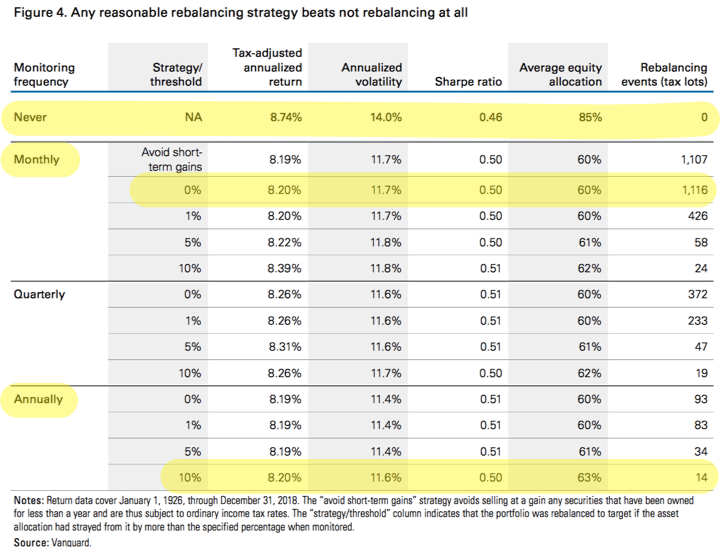 All this talk about portfolio rebalancing is to improve your risk-adjusted return, not to maximize absolute returns. You are trying to squeeze the most return out of a given degree of risk. Otherwise, if you do nothing eventually whatever has a higher return (historically always stocks) will outperform and take over the portfolio.
All this talk about portfolio rebalancing is to improve your risk-adjusted return, not to maximize absolute returns. You are trying to squeeze the most return out of a given degree of risk. Otherwise, if you do nothing eventually whatever has a higher return (historically always stocks) will outperform and take over the portfolio.
Here’s another take on the proper frequency of rebalancing your portfolio to your target asset allocation. Vanguard Research has a new paper called Getting back on track: A guide to smart rebalancing [pdf]. The chart below shows the results of various combinations of time and threshold rebalancing strategies on a traditional 60/40 portfolio from 1926-2018.

I added the yellow highlights, which focus on the two extremes:
- If you rebalanced every single month for 93 years straight (1,116 times!), your result would have been a 8.20% annualized tax-adjusted return and 11.7% volatility. Sharpe ratio 0.50.
- If you checked in your portfolio only once per year, and then only actually took actions if your target percentage was off by 10% of more (i.e. 50/50 or 70/30), you would have rebalanced only 14 times over 93 years. That an average of once every 6.6 years! Your result would have been a 8.20% tax-adjusted return and 11.6% volatility. Sharpe ratio 0.50.
My kids like to dance to a popular kids YouTube channel called Super Simple Songs. I think the last method should be called Super Simple Rebalancing. You just need to make sure you’re taking action on those rare trigger dates.
Historically, your risk-adjusted return was a bit better if you rebalanced at a 5% threshold with quarterly checkups (8.31% with 11.6% volatility), but there is no guarantee that this small edge will apply in the future. However, this does explain why Vanguard uses the 5%/quarterly method in their paid portfolio management program Vanguard Personal Advisor Services. Historically, this has worked out to rebalancing once every two years on average, which isn’t so bad either.
This last sentence in the paper is a good summary of tax-aware investing:
Investors may also be able to improve portfolio performance, without sacrificing risk control, by practicing tax-efficient rebalancing through the use of tax-advantaged accounts, rebalancing with portfolio income, incorporating tax- and cost-sensitivity awareness into their rebalancing decision, and gifting overweighted and highly appreciated securities.
Bottom line. You could have rebalanced 1,000+ times from 1926-2018, or you could have just done it 14 times and it really wouldn’t have made much difference. The key is to pick a simple, consistent rebalancing rule and stick with it!
 The Best Credit Card Bonus Offers – 2025
The Best Credit Card Bonus Offers – 2025 Big List of Free Stocks from Brokerage Apps
Big List of Free Stocks from Brokerage Apps Best Interest Rates on Cash - 2025
Best Interest Rates on Cash - 2025 Free Credit Scores x 3 + Free Credit Monitoring
Free Credit Scores x 3 + Free Credit Monitoring Best No Fee 0% APR Balance Transfer Offers
Best No Fee 0% APR Balance Transfer Offers Little-Known Cellular Data Plans That Can Save Big Money
Little-Known Cellular Data Plans That Can Save Big Money How To Haggle Your Cable or Direct TV Bill
How To Haggle Your Cable or Direct TV Bill Big List of Free Consumer Data Reports (Credit, Rent, Work)
Big List of Free Consumer Data Reports (Credit, Rent, Work)
With target retirement funds fees at Vanguard being so low, why not just do that and let them do the heavy lifting.
A perfectly good idea, as long as you are willing to give up the benefits of directing asset location for tax-efficiency and/or tax-loss harvesting.
Thank you for posting this – very interesting! I follow Larry Swedroe’s 5/25 rule, which I’m guessing might most closely resemble somewhere between the monthly 5% and monthly 10% rules listed in the chart.
I also contribute new money to the asset class most in need of a boost, so my frequency of actual rebalancing transactions in practice has been more like every 3 or 4 years, so a little more effort than the one at the bottom you highlighted.
One thing to note: It appears Vanguard did this analysis assuming securities were held in a taxable account, as they list tax-adjusted annualized return. Surely, there is more of a cost to rebalancing in a taxable account than if one is all in tax-advantaged accounts.
It seems like this might not be the best dataset to use for this comparison since the “do nothing” fares so well (with admittedly higher volatility). I suspect this is because the time span is too large, pushing all of the results together.
Yeah, because stocks have had such great performance in past history, the “do nothing” option progressively becomes a higher and higher stock allocation since there’s no rebalancing done. Note the 85% average equity allocation when all the other averages are much lower. If you’re going to go that route, maybe not really a good reason to start off with 40% bonds anyway? But if 40% bonds appeals to someone for risk reasons, rebalancing would be necessary to maintain that level of risk.
Oh, I definitely agree with that, I’m just saying that given that situation, I’m not sure there’s much insight to be gained by comparing the various rebalancing scenarios with that as the baseline.
I expect a much more useful comparison would be to aggregate all of the 30-year spans and compare those results. (or 40 or 50, perhaps)